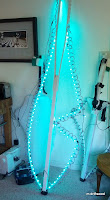I'm sure anyone reading this blog has noticed that I use a lot of stuff from
Cool Neon. It all stems from a random meetup at a laundry mat with a fellow vanagon geek. It was raining out and I was making coffee and cleaning the inside of my van, Siobhan, while my laundry dried. Another van pulled up and we eventually got to chatting and checking out each other's rigs. The other fellow's van had Cool Neon RBG LED ribbon lighting covering the inside that was all controlled by a little remote control. I loved it. Instantly wanted to do the same inside Siobhan. That was about 2 years ago. I have failed miserably at that. *shrugs*
 |
| One of my life's loves... Siobhan |
I was pretty impressed with what I saw and was pretty happy about my chance encounter. When I started having needs (yes, needs) for el-wire and more complex lighting, I turned to Cool Neon for the goods. So far, I've really liked working with a fun, bay area company; however, I have definitely learned some things about their products recently. Not bad things, just things a guy (or lady) would need to know in order to use them.
1. Controlling the lights
Total Control Lighting (TCL) is controlled over
SPI. You can totally control the lights with straight Arduino C++ and not need any other software. You could also connect these lights up to
*any* device that supports SPI. You do not have to use the Seeeduino that Cool Neon sells nor do you even have to use an Arduino compatible device. I haven't done it myself, but if you need more processing power and/or memory, you could even use
Raspberry Pi. Or maybe the crazy cheap
TI Launchpad?
Now, if you are using an Arduino compatible device, cool neon has some cool software to get you started. I definitely recommend using the TCL library from Chris De Vries. You can see it on his
site or get it on
github. It basically encapsulates all of the SPI controls and gives you simple functions like TCL.begin(), TCL.sendEmptyFrame(), and TCL.sendColor(r, g, b). Definitely handy.
If you're doing an LED Matrix setup for doing TV like effects and what not, they also have some handy
Windows visualization software to help do your design. I have not played with this one much as I'm doing all my light effects driven by sensor inputs and algorithms as opposed to pre-stored "videos." This is a whole blog topic on itself...
2. Arduino shields, Arduino's, & SPI
As I mentioned, TCL uses SPI to communicate. Different Arduino devices use different pins for SPI!
You can read all the bloody (not as bad as the red wedding) details of Arduino's SPI implementation
here. Specifically, check out the connections table a little past halfway down. It gives you the SPI pins for each Arduino model out there. Make sure to hook the TCLs up according to your device. The
Seeeduino that cool neon sells is basically a Duemilanove (you need to know that for SPI stuff as well as working in the
Arduino IDE). The
Seeeduino Mega they sell is compatible with the
Arduino Mega 1280 which uses different SPI pins (50, 51, 52, and 53 as opposed to the duemilanove's 12, 11, 13, and 10). I only had to switch from 11 and 13 to 51 and 52 when I switched from the seeeduino to an Arduino Mega.
Important! All of the above means that the shields that Cool Neon sells are
*not* compatible with the Megas. They are connected directly to the duemilanove's pins and will not function on a Mega.
3. Power
Another tidbit I learned recently is that having multiple power sources -- one for your controller and one for your lights -- is a great idea!
When you do that, make sure to hook up the ground for the lights to the power supply for the lights
*and* the controller's ground. I think Chris De Vries has a reference to this on his site and that's where I figured it out.
My understanding from Cool Neon is that the lights can be plugged directly into a power supply that's between 5V and 7 or 7.2V. I'm using a little 6V lead-acid deep cycle battery from
batteries plus and it's working great.
4. Other Light Sources
So I don't feel too much like a little Cool Neon fan boy, I think I should mention that lights
like the TCLs can be found elsewhere. I have not purchased any from other places as I like supporting a local, burner friendly company and the lights they sell have held up great for me. I also appreciate the customer service they offer.
I'm also becoming increasingly aware of the fact that a lot of cheap electrical components come from China and I do not like a lot of their labor or political practices (note that I have not looked into Cool Neon's component sources). Keep that in mind when you buy anything, but especially electrical goods. The cheap stuff is cheap! But, it usually comes from China and probably involves slave labor. If you want a good idea of how much decisions like this support the slave trade, check out
http://slaveryfootprint.org.
[EDIT 13 Jun 2013] Just got a note from Cool Neon saying that they have been to the Seeed Studio factory in China that makes the arduino compatible boards they sell and that the factory conditions and ethics there seem top notch. Good to hear!
 First off, it's San Francisco Decompression on Sunday the 13th. I'll be there post brunch to hang out, dance, and enjoy the sights. Come sunset, LightWalker will stroll about and help light up the streets.
First off, it's San Francisco Decompression on Sunday the 13th. I'll be there post brunch to hang out, dance, and enjoy the sights. Come sunset, LightWalker will stroll about and help light up the streets.
























